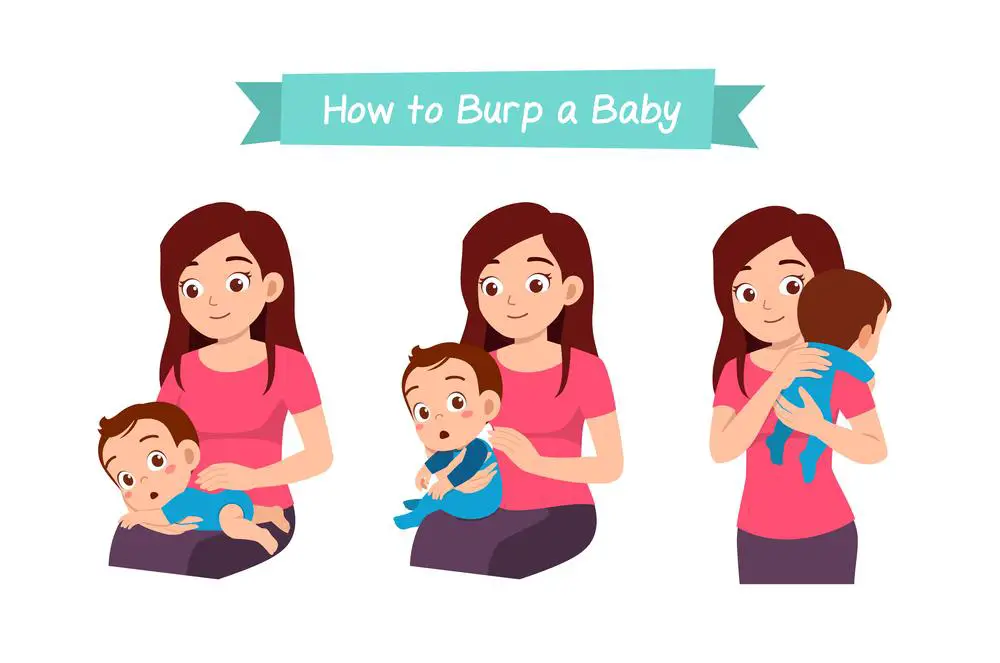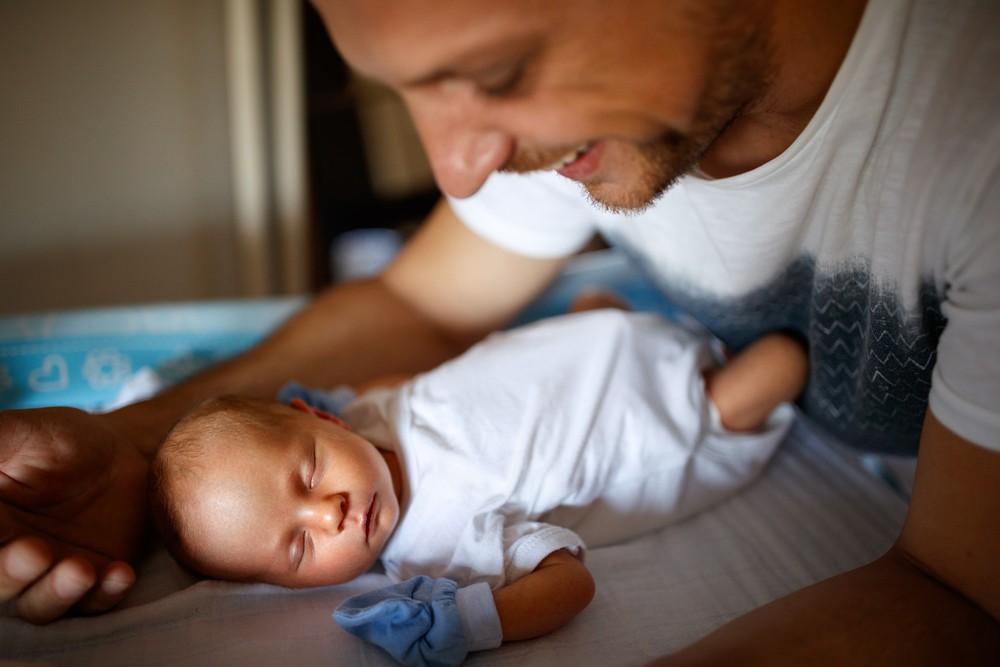As a BetterHelp affiliate, we receive compensation from BetterHelp if you purchase products or services through the links provided
Putting your baby to sleep without burping after a feeding session may be something you’re considering. Maybe your little one drifts off so peacefully it feels wrong to wake them. On the other hand, you might wonder if skipping burping could lead to discomfort from trapped gas. Indeed, burping is an age-old practice designed to help release air babies inadvertently swallow during feeding, which could potentially cause gas and irritability.
Understanding when and how to burp your baby is crucial for their comfort and your peace of mind. Not all babies need to be burped to the same extent, as it often depends on how much air they take in during feeding. Some feeding practices and positions can help reduce the amount of air swallowed, possibly diminishing the need for burping afterward. Nonetheless, some parents may find that their babies do just fine without a burp pre-sleep, while others may notice signs of discomfort that signal the need for a gentle, soothing burp.
Consulting with a pediatrician can provide tailored guidance on burping based on your baby’s needs and feeding habits. As caregivers, you play a pivotal role in observing and responding to your baby’s signals – whether that means developing a burping routine or transitioning towards more independent sleep without the burping step.
Key Takeaways
- Burping helps release swallowed air, but the need varies among babies.
- Feeding techniques and positions can reduce the need for burping.
- Consult with a pediatrician for advice tailored to your baby’s needs.
Understanding the Importance of Burping for Babies

Before your baby drifts off to dreamland, it’s critical to understand why helping them burp can prevent discomfort and fussiness due to trapped air.
What Is Burping?
Burping is your way of helping your baby release air swallowed during feeding. When your baby takes in milk, they also swallow air, which gets trapped in their stomach. This air needs to come out, and that’s where burping comes in—it’s a natural process to alleviate that excess gas.
Key Takeaway: Burping helps minimize your baby’s discomfort from trapped air.
Why Burping Is Essential
- Prevents Discomfort: Your newborn’s digestive system is still developing, and burping can help relieve any discomfort caused by excess gas.
- Reduces Fussiness: Babies become fussy when they’re uncomfortable. By burping your baby, you’re helping them stay calm and content.
- Aids Digestion: Effective burping can aid your baby’s digestion, making it easier for their tiny systems to process milk and formula.
Remember: Ensuring your baby burps after feeding is a simple step in supporting their comfort and well-being.
Recognizing When to Burp Your Baby
In the early months of your baby’s life, burping is a crucial step in feeding routines to help reduce discomfort from trapped air. Understanding when and how to burp your baby can improve their well-being.
Cues for Burping
- Fussiness: If your baby is getting fussy during or after a feeding, it could be a sign of discomfort from gas.
- Wriggling or Squirming: A baby that squirms or seems uncomfortable while feeding might need a burp.
- Feeding breaks: Even if your baby isn’t showing discomfort, offering a burp after a pause in feeding can be helpful.
Key Takeaway: Tune into your baby’s behavior; fussiness and squirming often signal it’s time to burp.
Burping By Baby’s Age
- 0-2 months: Newborns may need more frequent burping. It’s usually good to burp them every 2-3 ounces (60-90 milliliters) if bottle-feeding or when switching breasts if nursing.
| Baby’s Age | During Feeding | After Feeding |
|---|---|---|
| 0-2 months | Every 2-3 ounces / switching breasts | Always |
| 3+ months | If fussy or taking breaks | Depending on the baby |
- 3+ months: As infants age, they might not need to burp as much. Still, be responsive to their needs, especially if they’ve been fussy or their feeding position has changed during a session.
Key Takeaway: Your baby’s age can inform the frequency of burping—newborns often need it more than older babies.
Pros and Cons of Skipping Burping Before Sleep
Deciding whether to burp your baby before sleep involves weighing the potential for increased comfort against the risk of sleep disruptions. Here’s what you need to know.
Advantages of Non-Burping Sleep Routine
Putting your baby down without burping might have its benefits:
- Shorter bedtime routine: You might save time if you choose not to burp. For some babies, especially older ones, falling asleep can be easier when not disturbed by burping.
- Less disruption: Your baby might be sleeping soundly right after feeding. In such cases, skipping burping can avoid waking them.
Key takeaway: A non-burping sleep routine could mean a quicker and less disruptive bedtime for an older baby with fewer spit-up episodes.
Potential Consequences of Not Burping
Not burping a baby before sleep can also have a few downsides:
- Increased spit-up: Babies with reflux might experience more spit-up if not burped because the air trapped in their stomachs may push milk up.
- Discomfort or colic: Some babies might feel uncomfortable or experience colic symptoms due to gas if they don’t burp before sleeping.
Key takeaway: If your sleeping baby often faces discomfort, spit-up, or colic episodes after feedings, burping before sleep can be an essential step in their bedtime routine.
Safe Burping Techniques
Ensuring your baby is comfortably burped can contribute to their well-being after feeding sessions. Below, you will find proven techniques to burp your baby effectively and gently.
Effective Positions for Burping
- Upright Position against Your Shoulder: Hold your baby firmly against your shoulder, supporting their bottom with one hand. Gently rub their back with the other hand to encourage a burp.
- On Your Lap: Sit your baby on your lap, facing away from you. Lean them slightly forward while you support their chest with one hand and use the other to pat their back.
Key takeaway: Finding a comfortable position is essential; your baby’s relaxation can aid in more effective burping.
Gentle Burping Methods
- Gentle Pats or Rubs: Use a soft touch when patting or rubbing your baby’s back. Intense pressure is unnecessary and can be uncomfortable for your infant.
- Seated Position: If your baby prefers sitting up, support their head and chest with one hand while gently patting their back with the other.
Key takeaway: Even in your quest for that elusive burp, ensure you’re using a gentle touch—a calm baby means an easier burping experience.
Remember, if you’re having trouble with these methods or if your baby seems uncomfortable, it’s always wise to consult with your pediatrician to get personalized advice.
Burping a Sleeping Baby: Is It Necessary?

Determining if you need to burp your baby after they’ve fallen asleep is not always clear-cut. Consider the baby’s comfort and likelihood of restlessness due to trapped air versus the benefit of uninterrupted sleep.
Assessing the Need for Burping
When your little one dozes off during or after feeding, you might wonder if you should wake them to burp. Not every baby will need to burp after every feeding, but some signs to watch for include:
- Restlessness or squirming, even while sleeping, could indicate discomfort from trapped air.
- A baby who consistently wakes up crying shortly after being put down might benefit from burping.
If your baby sleeps peacefully and doesn’t showcase recurring discomfort, they might be fine without that post-feeding burp.
Key Takeaway: Pay attention to your baby’s cues—restlessness could mean they need that burp, but a peaceful sleeper likely does not.
Minimizing Sleep Disruptions
If you decide your baby needs to burp, do so gently to minimize disruption:
- Lay your baby on your lap and gently pat their back.
- Hold your baby against your chest, supporting their head, and rub or pat their back.
- Use a relaxing, calming effect to smooth the transition to and from sleep.
Remember, it’s a balance—if possible, your goal is to release trapped air without causing wakefulness.
Key Takeaway: If burping is necessary, do it gently to keep sleep disruptions at a minimum.
Feeding Practices to Reduce the Need for Burping
Making sure your little one is comfortable after feeding is essential, and there are specific techniques you can use while breastfeeding or bottle-feeding to minimize the chances of gas bubbles that can make your baby fussy.
Breastfeeding Techniques
When breastfeeding, the position of your baby can make a significant difference. You should aim to:
- Keep your baby’s head slightly higher than the stomach. This positioning helps milk flow more smoothly to the bottom of the stomach, reducing the likelihood of gas buildup.
- Implement the laid-back breastfeeding position involves reclining and placing your baby on your stomach, encouraging a more natural latch.
Key Takeaway: Nursing in a position that elevates your baby’s head can reduce the need for burping afterward.
Bottle-Feeding Tips
Bottle-feeding requires attention to detail in both the preparation of formula and the actual feeding technique to avoid excess air:
- Always make sure the bottle’s nipple is full of milk. This prevents your baby from swallowing air.
- Choose a slow-flow nipple, as it reduces the air your baby might take in and allows them to eat at a more measured pace.
- Let the mixed formula settle before feeding to reduce air bubbles if you’re using formula.
- Remember to take breaks to allow your baby to digest.
Key Takeaway: A proper bottle with a slow-flow nipple and settled formula can significantly reduce gas and the need for burping.
Managing a Gassy Tummy Without Burping
If your baby struggles with a gassy tummy but burping isn’t an option, fret not. There are effective methods you can try to alleviate their discomfort through diet and alternative soothing techniques.
Dietary Considerations
When introducing solid foods to your baby’s diet, starting with easily digestible options is essential. Here’s a quick guide to managing your little one’s diet:
- Introduction of Solid Foods: Begin with simple, single-grain cereals or pureed vegetables and fruits, as they are gentler on the stomach.
- Monitor Reactions: Watch for any signs of gas or discomfort after meals. If a particular food seems to cause issues, take a break from it.
- Hydration: Ensure your baby stays well-hydrated with breast milk or formula, as proper hydration can aid digestion and reduce gas.
Key Takeaway: Introduce new solid foods slowly, watch for any signs of a gassy tummy, and adjust the diet to help soothe your baby’s stomach.
Alternative Soothing Techniques
Besides diet, several gentle, non-invasive techniques can help manage your baby’s gassy tummy:
- Gentle Massage: Using circular, clockwise strokes around your baby’s belly can provide a calming effect and facilitate the movement of gas.
- Tummy Time: While awake and supervised, place your baby on their stomach to encourage movement and gas expulsion.
- Positioning: Keep your baby upright for a while after feeding; this can naturally help reduce gas buildup.
Key Takeaway: Employing gentle massages, introducing tummy time, and positioning your baby properly can contribute to easing gassy discomfort without the need for burping.
Pediatrician Guidelines on Burping
When it comes to your little one’s comfort and sleep, understanding when and how to burp them is key. Pediatricians emphasize the importance of safely incorporating burping into your baby’s sleep routine.
Expert Advice on Burping Frequency
Pediatricians advise that babies must be burped after feedings to help release gas that may cause discomfort. The frequency, however, may vary depending on the baby:
- Younger Infants (0-3 months): They often require frequent burping, sometimes after every few ounces during feedings.
- Older Infants: As they grow, they may not need to burp as often and will start to expel gas naturally.
Key Takeaway: Your baby’s need to burp decreases as they develop. Be observant and responsive to their cues.
Professional Recommendations for Sleep and Burping
Safe sleep guidelines recommend you keep a few things in mind regarding burping and sleep:
- Before Lying Down: Attempt to burp your baby before putting them down to sleep.
- Positioning After Feeding: If your baby hasn’t burped and needs to sleep, it’s generally okay. You might consider placing them on their back in a safe sleep environment.
- Consult Your Pediatrician: Certain infants, especially those with reflux, may need personalized burping strategies.
Key Takeaway: Let your baby sleep without burping is typically safe, but ensure they’re lying in a crib free of loose bedding or toys.
The Role of Caregivers in Baby’s Burping Routine
When managing a baby’s burping routine, your role as a caregiver is critical. You must be well-informed and consistent to ensure the little one’s comfort and well-being.
Educating Caregivers on Burping
Proper burping techniques are essential for any caregiver, especially if you’re new to childcare. Here are three fundamental positions you might use:
- Over the Shoulder: Hold the baby against your chest with their chin resting on your shoulder, then gently pat their back.
- Sitting Up: Sit the baby on your lap, lean them slightly forward, and support their chest and head with one hand while patting their back.
- Lying Across the Lap: Place the baby face-down on your lap, ensuring their head is higher than their chest, and gently pat their back.
Key takeaway: Familiarity with multiple burping positions allows you to soothe the baby effectively.
Building Consistency in Baby Care
Consistency is the backbone of effective baby care. As a caregiver, your job is to:
- Develop a routine that includes burping at similar times each day, such as after feedings.
- Recognize cues the baby needs to burp, like fussiness or squirming during and after feeding.
By doing so, you’ll create a nurturing environment that’s conducive to your baby’s comfort and digestion.
Key takeaway: Stick to a consistent burping schedule to help reduce discomfort for the baby.
Transitioning From Burping to Independent Sleeping
As your little one grows, transitioning from assisted burping to falling asleep unaided is an important developmental milestone.
Reducing Burping As Baby Grows
You’re probably aware that when babies are newborns, burping during and after feedings is vital to helping them release trapped air that can make them fussy. However, as your baby ages, they develop stronger digestive systems and become better at removing excess air. Here’s how you can gently reduce the burping routine:
- Around 4-6 months: Start to observe your baby’s cues. You can gradually lessen the burping sessions if they seem content after feeding without burping.
- Tips: Gradually extend the time between burps during feedings, or try cutting out one burping session at a time.
Key Takeaway: Look for signs of comfort in your baby post-feeding to decide when to cut down on burping.
Encouraging Self-Settling
By the time your baby is a few months old, they might begin showing signs that they can settle themselves to sleep. Encouraging this ability is beneficial for their sleep patterns. Here’s what you can do:
- Create a soothing environment: Maintain a calm and quiet bedroom with a comfortable temperature.
- Establish a routine: Implement consistent bedtime practices that signal it’s time to wind down.
- Dream feeds: Before you head to bed, consider giving a dream feed to minimize the chances of your baby waking up hungry soon after.
- Drowsy but awake: Lay your baby in their crib when they’re drowsy yet still awake to foster self-soothing.
Key Takeaway: Strengthen your baby’s self-soothing abilities by setting a routine and fostering the right sleep environment.
Answering Common Concerns About Baby Burping
When it comes to your baby’s comfort and digestive health, understanding the role of burping is essential. Let’s address two key issues that you might encounter.
Navigating Spitting Up and Reflux
Spitting up, also known as gastroesophageal reflux, is common in babies and usually isn’t a cause for concern. This happens because their lower esophageal sphincter is underdeveloped. Here’s what you need to know:
- Reflux: If your baby spits up frequently after meals but seems content and healthy, they’re likely experiencing normal baby reflux.
- How to Burp: Gently patting your baby mid-feed and after feeding can help minimize spitting up.
- FAQ: “Is burping always necessary?” While beneficial, some babies may not need to burp after every feeding if they don’t swallow much air.
Key takeaway: Burping helps reduce spitting up and reflux, but if your baby is not distressed, occasional skipping of burping may be okay.
Dealing With Colic and Gas Issues
Dealing with a colicky or gassy baby can be stressful. There’s a suspicion that trapped gas bubbles contribute to this discomfort.
- Colic: It’s characterized by periods of intense, unexplained fussing and crying in an otherwise healthy baby.
- Swallowing Air: This often happens when babies feed rapidly or cry before providing, leading to more gas.
- Strategies: To combat gas issues, try burping your baby every time they pause during feeding or switch breasts or bottles.
- Tips:
- Keep your baby upright during feeding to reduce air swallowing.
- Implement a gentle tummy massage or bicycle leg movement after feeding for gas relief.
Key takeaway: Effective burping can alleviate colic and trapped gas, improving your baby’s well-being and offering you peace of mind.
Frequently Asked Questions
Knowing how to handle burping can give you peace of mind when putting your baby to sleep. These frequently asked questions provide essential insights to guide you through the process.
What should I do if my baby doesn’t burp after a feeding?
If your baby doesn’t burp after feeding, gently lay them on their back for a few minutes, then try burping again. Sometimes, a little activity or change in position can encourage a burp to come up. Remember, some babies may not need to burp every time.
Is there a risk of choking if my baby hasn’t burped before sleeping?
Generally, the risk of choking is low if your baby hasn’t burped before sleeping, especially if they’re put down on their back, which is the safest position. Make sure you always follow safe sleep guidelines to minimize any risks further.
At what age is it no longer necessary to burp my child?
Most babies will need less help with burping when they’re 4-6 months old. As they grow older and their digestive systems mature, they can burp independently and will not require as much assistance from you.
How can I burp my baby if they fall asleep during or after feeding?
If your baby falls asleep during or after feeding, try burping them while resting on your shoulder or laying them down on their stomach across your lap and gently patting their back. This gentle motion can often help release any trapped air without fully waking your child.
What are the consequences of my baby going to sleep without burping?
Most of the time, a baby going to sleep without burping won’t face any serious consequences. It may sometimes lead to mild discomfort or a little extra gas. If your baby seems content and sleeps well, they’re likely just fine, even if they haven’t burped.
Can my baby be put down to rest even if they haven’t burped yet?
Yes, you can put your baby down to rest even if they haven’t burped yet. However, you might want to consider their usual needs and habits. If your baby frequently experiences gas or discomfort, additional burping may help them sleep more soundly. The key takeaway is to follow your baby’s cues and comfort level.
- Stress Management: What is the Relationship Between Stress and Addiction? - June 28, 2024
- Exploring Techniques to Maintain a Healthy Lifestyle without Drugs - May 28, 2024
- How Acupuncture Helps Treat Chronic Fatigue Syndrome - May 28, 2024
This site contains affiliate links to products. We will receive a commission for purchases made through these links.




